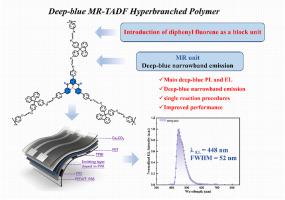超支化MR-TADF聚合物溶液加工柔性窄带oled的刚柔平衡工程
IF 4.2
3区 工程技术
Q2 CHEMISTRY, APPLIED
引用次数: 0
摘要
虽然多共振热激活延迟荧光(mrtadf)材料由于其窄带发射和高激子利用率而成为有机发光二极管(oled)的研究热点,但其刚性的平面结构阻碍了溶液可加工性和柔性薄膜的制备。本文首次提出了以MR-TADF单元为核心,以二苯基芴为嵌段单元的“刚柔平衡”分子工程策略,设计合成三维树突状高分子材料。树枝状拓扑结构通过位阻有效抑制分子间π-π堆积,将光致发光量子产率提高到60%,并减少非辐射跃迁。独特的非共轭柔性连杆结构不仅保留了深蓝MR芯的高色纯度(CIE: 0.14, 0.12),而且显著降低了骨干刚度,使材料具有优越的溶液加工性和机械柔韧性。这种设计与PVK相结合,可以形成优异的交错膜,进一步提高器件在弯曲条件下的稳定性,解决了传统刚性MR-TADF材料在柔性应用中的关键挑战。基于该超支化聚合物的oled具有4.2 V的低导通电压、8.5%的高外量子效率(EQE)和52 nm的窄发射峰(FWHM)。值得注意的是,即使在柔性器件反复弯曲后,它们仍保持5.9%的EQE并保持窄带特性。这项工作为克服平面MR-TADF材料的局限性提供了一种创新的解决方案,突出了超支化聚合物在柔性oled中的独特优势。本文章由计算机程序翻译,如有差异,请以英文原文为准。

Hyperbranched MR-TADF polymers with rigid-flexible balance engineering for solution-processed flexible narrowband OLEDs
Although multiple resonance thermally activated delayed fluorescence (MR-TADF) materials have emerged as a research hotspot in organic light-emitting diodes (OLEDs) due to their narrowband emission and high exciton utilization efficiency, their rigid planar structures hinder solution processability and flexible film fabrication. Herein, a “rigid-flexible balance” molecular engineering strategy is proposed to design and synthesize three-dimensional dendritic polymer materials for the first time, featuring MR-TADF units as the core and diphenyl fluorene as block units. The dendritic topology effectively suppresses intermolecular π-π stacking through steric hindrance from the block units, enhancing photoluminescence quantum yield to 60 % and reducing non-radiative transitions. The unique non-conjugated flexible linkage architecture not only preserves the high color purity of the deep blue MR core (CIE: 0.14, 0.12) but also significantly reduces backbone rigidity, endowing the material with superior solution processability and mechanical flexibility. This design, combined with PVK, can form excellent interloped films to further improve the device's stability under bending conditions, solving a key challenge for traditional rigid MR-TADF materials in flexible applications. The OLEDs based on this hyperbranched polymer exhibit a low turn-on voltage of 4.2 V, high external quantum efficiency (EQE) of 8.5 %, and narrow emission with FWHM of 52 nm. Remarkably, even after repeated bending of flexible devices, they retain an EQE of 5.9 % with maintained narrowband characteristics. This work provides an innovative solution to overcome the limitations of planar MR-TADF materials, highlighting the unique advantages of hyperbranched polymers in flexible OLEDs.
求助全文
通过发布文献求助,成功后即可免费获取论文全文。
去求助
来源期刊

Dyes and Pigments
工程技术-材料科学:纺织
CiteScore
8.20
自引率
13.30%
发文量
933
审稿时长
33 days
期刊介绍:
Dyes and Pigments covers the scientific and technical aspects of the chemistry and physics of dyes, pigments and their intermediates. Emphasis is placed on the properties of the colouring matters themselves rather than on their applications or the system in which they may be applied.
Thus the journal accepts research and review papers on the synthesis of dyes, pigments and intermediates, their physical or chemical properties, e.g. spectroscopic, surface, solution or solid state characteristics, the physical aspects of their preparation, e.g. precipitation, nucleation and growth, crystal formation, liquid crystalline characteristics, their photochemical, ecological or biological properties and the relationship between colour and chemical constitution. However, papers are considered which deal with the more fundamental aspects of colourant application and of the interactions of colourants with substrates or media.
The journal will interest a wide variety of workers in a range of disciplines whose work involves dyes, pigments and their intermediates, and provides a platform for investigators with common interests but diverse fields of activity such as cosmetics, reprographics, dye and pigment synthesis, medical research, polymers, etc.
 求助内容:
求助内容: 应助结果提醒方式:
应助结果提醒方式:


